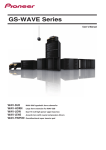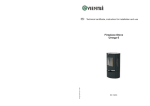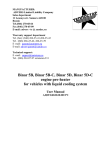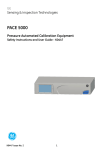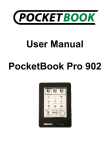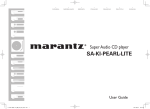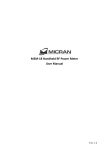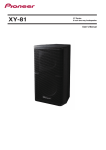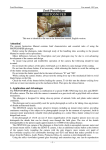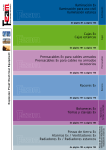Download Druck DPI 820 - GE Measurement & Control
Transcript
GE Sensing Druck DPI 820 Dual input thermometer User manual - K0386 Customer service A1 B1 10 10 10a 9a 1 9 A2 8 2 7 3 6 11 4 5 B1 12 A2 16 15 14 13 22 17 18 21 19 20 K0386 Issue 2 Visit our web site: www.gesensing.com Table of Contents Introduction ......................................................................... 1 Safety ..................................................................................... 1 Marks and symbols on the instrument ................................. 2 To start .................................................................................. 2 Location of items ............................................................................ 2 Items on the display ...................................................................... 2 Prepare the instrument ................................................................ 2 Power on or off ................................................................................ 2 Set up the basic operation ......................................................... 3 Select a task (Measure) ................................................................ 3 Set up the settings ......................................................................... 3 Edit functions .................................................................................... 4 Operation .............................................................................. 4 Thermocouple connections ....................................................... 4 Communications port connections ........................................ 4 Measure temperature .................................................................. 5 UPM Pressure measurements .................................................. 5 Use the Snapshot functions ....................................................... 6 Error indications .............................................................................. 7 Maintenance ........................................................................ 8 Clean the unit ................................................................................... 8 Replace the batteries .................................................................... 8 Calibration ............................................................................ 8 Before you start ............................................................................... 8 Procedures (mV input) .................................................................. 9 Procedures (CJ input) .................................................................... 9 Procedures (IDOS UMM) ............................................................... 9 Specification data ............................................................... 9 General ................................................................................................ 9 Temperature ranges .................................................................. 10 mV range ......................................................................................... 10 Customer service ............................................... Back cover © 2007 General Electric Company. All rights reserved. Trademarks All product names are trademarks of their respective companies. Introduction The DPI 820 Dual Input Thermometer is part of the Druck DPI 800 series of hand held instruments. The DPI 800 series uses Intelligent Digital Output Sensor (IDOS) technology to give instant plug and play functionality with a range of Universal Measurement Modules (UMM). Example: the Universal Pressure Module (UPM). The DPI 820 includes these functions: Function * Measure temperature: T1 and/or T2 * Measure temperature difference: T1 - T2 * Cold Junction (CJ) compensation: Automatic/Manual Snapshot: Up to 1000 displays with a date/time stamp Communications port: IDOS or RS232 Language selection ** Measure pressure/Leak test: External IDOS UPM Other functions: Hold, Maximum/Minimum/Average, Filter, Tare, Scaled values, Backlight, Alarm * ** Refer to “Specification data”. Optional item Safety Before you use the instrument, make sure that you read and understand all the related data. This includes: all local safety procedures, the instructions for the UMM (if applicable), and this publication. WARNING • It is dangerous to ignore the specified limits for the instrument or to use the instrument when it is not in its normal condition. Use the applicable protection and obey all safety precautions. • Do not use the instrument in locations with explosive gas, vapor or dust. There is a risk of an explosion. • To prevent electrical shocks or damage to the instrument, do not connect more than 30V between the terminals, or between the terminals and the ground (earth). • UPM only. To prevent a dangerous release of pressure, isolate and bleed the system before you disconnect a pressure connection. Continued K0386 Issue 2 [EN] English - 1 Safety (Continued) To start - Items on the display A2 Before you start an operation or procedure in this publication, make sure that you have the necessary skills (if necessary, with qualifications from an approved training establishment). Follow good engineering practice at all times. Safety - Marks and symbols on the instrument Complies with European Union directives Warning - refer to the manual Read the manual Battery Ground (Earth) ON/OFF Do not dispose of this product as household waste. Refer to “Maintenance”. Item 13. Refer to: Select Task (Table 2) 14. 15. 16. The measured value satisfies one of the alarm conditions. Refer to: Settings (Table 3) The data on the display is on hold. To continue, press the HOLD button again. The Snapshot function is set up to record the data on the display (Keypress or Periodic). Refer to “Operation” (Table 4) 17. Shows the battery level: 0 ... 100%. 18. Identifies the type of data: measurement range, units, thermocouple type (K, J, T ... ), T1/T2 - If applicable. = Input = IDOS Input T1/T2 Identifies the thermocouple connector 19. To start Description UPM only. Task indication for the leak test. Refer to: Select Task (Table 2) Shows the settings applied to the input (If applicable). 123ABC = x:y scaled value To start - Location of items A1 Item 1. 2. ❍ ■■ 3. ESC 4. 5. 6. 7. 8. 9. 9a. 10. 10a. 11. 12. ▲ ▼ Description On or off button. Left-hand soft-key. Selects the function above it on the display (Item 20). Example: Edit Moves back one menu level. Leaves a menu option. Cancels the changes to a value. Increases or decreases a value. Highlights a different item. Holds the data on the display. To continue, press the HOLD button again. If Snapshot is on (Item 16): HOLD records the data on the display. Shows the Select Task menu. MENU Selects or accepts an item or value. OK Selects [✓] or cancels [ ] a selection. HOLD ■■ SENSOR / PC Right-hand soft-key. Selects the function above it on the display (Item 20). Example: Settings Display. Refer to A2 Communications port. Use to connect a Universal Measurement Module (UMM) or a RS232 cable. Optional item - Part No. IO800D: RS232 cable (5-pin to 9-pin D type connector). Use to copy the snapshot records to a PC or to a printer. Refer to “Operation”. Thermocouple connector: Refer to “Operation”. Type K thermocouple (two included). Connection point for some of the optional accessories. Refer to the datasheet. Battery compartment. Refer to B1. 2 - [EN] English = Filter = Tare Refer to: Settings (Table 3) = Maximum = Average = Minimum 20. A soft-key function. To select an available function, press the soft-key below it. Example: 21. The measured value or values applicable to the task selection. 22. The Edit display to set up text labels ( ≤ 6 characters): Snapshot (Table 1), x:y Scaling (Table 3). OK = Accept the new text label Shift = Change the keys: 123ABC or -_+abc = Move left = Move right = Add a space BS = Back space (Delete character) To start - Prepare the instrument Before you use the instrument for the first time: • Make sure that there is no damage to the instrument, and that there are no missing items. • Remove the plastic film that protects the display. Use the tag (◗ ) in the top right-hand corner. • Install the batteries (refer to B1). Then re-attach the cover. To start - Power on or off To turn the instrument on or off, press ❍ (A1 - item [1]). The instrument does a self test and then shows the applicable data. When the power is off, the last set of configuration options stays in memory. Refer to “Maintenance”. K0386 Issue 2 To start - Set up the basic operation Use the Set Up menu to set up the basic operation of the instrument. 1 Menu: Select Task 2 3 Menu: Set Up ▲ ▼ (Table 2) 4 5 1 Menu: Select Task ▲ ▼ (Table 1) 2 3 Display: T2 input ▲ ▼ [✓]/[ ] If there is additional data for a menu option, select Settings (■ ■) to see the values that are set up. If necessary, adjust the values. Table 1: Menu options - Set Up Options (If applicable) To start - Select a task (Measure) When the instrument is set up (Table 1), use the Select Task menu to select the applicable task. (Table 2) Table 2: Menu options - Select Task Description To set up and use the Snapshot functions. Additional data: Refer to “Operation” (Table 4) ... Scale To select the applicable international temperature scale: IPTS 68 or ITS 90. CJ ... To select the type of cold junction (CJ) compensation. Automatic: The instrument monitors the CJ temperature and applies the necessary CJ compensation. Manual: Measure the CJ temperature and set the applicable value. The instrument uses this value to apply the necessary CJ compensation. Additional data (Manual): Select Settings (■ ■) To select and set up the backlight facility + timer. Additional data: Select Settings (■ ■) To select and set up the power off facility + timer. Additional data: Select Settings (■ ■) To show the battery level (%). To set the display contrast (%). ▲ Increases %, ▼ decreases % To set the time + date. The calibration facility uses the date to give service and calibration messages. Snapshot adds a date/time stamp to each display. To set the language option. To calibrate the instrument. Additional data: Refer to “Calibration”. To select and show the applicable status data. (Software Build, Calibration Due date, Serial Number, IDOS Information). Sk2 = Settings In Table 2, IDOS is a Universal Measurement Module (UMM). If you attach a UMM to the communications port (A1 - item [9]), the Select Task menu shows the applicable IDOS options. Options (If applicable) Description T1 Selects one temperature measurement task (T1, T2, T1-T2). T1-T2 gives the temperature difference. Selects two temperature measurement tasks (T1 and T2). IDOS UMM only. An IDOS measurement task. UMM only. Selects one temperature measurement task (T1, T2, T1-T2) + an IDOS measurement task. UPM only. Selects the IDOS pressure measurement task + leak test. IDOS To set up the way the instrument works. Additional data: Refer to: Set Up (Table 1). To start - Set up the settings When the task is set up (Table 2), use the Settings menu to adjust the measurement operation. Display: Task T1, T2 1 Settings selection (If applicable) 2 3 ▲ ▼ ■■ Sk2 = Settings Menu: Settings 4 5 ▲ ▼ (Table 3) 6 Settings x:y ■■ [✓]/[ ] Sk1 = Edit If there is additional data for a menu option, select Settings (■ ■) to see the values that are set up. If necessary, adjust the values. Refer to “Edit functions”. K0386 Issue 2 [EN] English - 3 Table 3: Menu options - Settings Options Description (If applicable) ... Units To select the temperature units (°C or °F). UPM only = “Pressure Units” if you select an IDOS task (Table 2). Select one of the fixed units of measurement (psi, mbar ... ). ... type To select an applicable thermocouple type (K, J, T ... ) To include maximum, minimum and average values for the measurement task. Only available when there is one input measurement task. To select and set up a tare value for the measurement task (a specified value or the reading on the display). The instrument subtracts a positive tare value, and adds a negative tare value. Additional data: Select Settings (■ ■) To select and set up a scale of values: One local scale for each measurement task (Maximum: 5). Additional data (Example 1/2): Select Settings (■ ■) To start - Edit functions Example 1) Set up a label for x:y Scaling = %. Settings x:y To select and set up the alarm values for the measurement task (maximum and minimum). Additional data: Select Settings (■ ■) UPM only. Gage sensors or sensors with differential operation. A zero correction that makes the instrument read zero at local pressure. Leak Test only. To set an applicable period for the leak test (Hours:Minutes:Seconds). 4 - [EN] English Edit ■■ Sk1 = Edit 2 Edit ▲ ▼ ■■ Shift 3 A2 - item [22] Edit ... Edit 4 5 %_ OK ▲ ▼ ■■ A2 - item [22] Example 2) Set up values for x:y Scaling = 0 to 100%. Settings x:y To select and set up the filter values to give a smoother output for the measurement task: Band as a % of full scale (FS). The filter compares each new value with the previous value. If the new value is outside the band, it is not filtered. Low pass filter time constant in seconds. Increase the value to increase damping factor. Additional data: Select Settings (■ ■) 1 1 ▲ ▼ Settings x:y 2 ■■ Edit 3 4 ▲ ▼ ■■ Sk1 = Edit Operation This section gives examples of how to connect and use the instrument. Before you start: • Read and understand the “Safety” section. • Do not use a damaged instrument. Operation - Thermocouple connections Attach the thermocouple wires to the applicable thermocouple mini-connector (Figure 1). The wider blade is the negative. Then attach the connector to the instrument. Operation - Communications port connections Use the communications port (A1 - item [9]) to attach an IDOS Universal Measurement Module (UMM) or an RS232 device. IDOS Communications When you attach the cable from a UMM (Figure 3/4), the instrument automatically changes the menus to give you all the applicable options (Table 2). RS232 Communications Use an RS232 cable (A1 - item [9a]) to transmit all the Snapshot data to a PC or a printer (Table 4). K0386 Issue 2 Operation - Measure temperature To measure temperature: 1. Connect the applicable thermocouples (Figure 1/2) and, if necessary, adjust the Set Up (Table 1). 2. Select a Temperature input task from Select Task (Table 2) and, if necessary, adjust the Settings (Table 3). T1 K K T2 T1 K T2 K T1 T2 Reference T1 T2 T1 T2 Settings a) T1 - T2 Figure 2: Example configuration - To measure the temperature difference Operation - UPM Pressure measurements Read all the instructions supplied with the UPM and then use the specified procedures to connect it (Figure 3/4). Settings a) T1 or T2 Settings b) T1 and T2 Figure 1: Example configurations - To measure the temperature with one or two thermocouples The examples in Figure 1 show how to compare temperatures or measure different temperatures in a system. Settings a) Pressure Start Settings b) Leak test Figure 3: Example configuration - Pressure measurement with a UPM K0386 Issue 2 [EN] English - 5 When the connections are complete, make the necessary IDOS selections (Table 2). If you re-attach a UPM, the instrument uses the same measurement units that you used before. The instrument keeps a record for the last 10 modules. UPM - Measure the pressure To measure the pressure (Figure 3): Operation - Use the Snapshot functions Use Snapshot to record up to 1000 displays then examine the results on the display, or transmit all the data to a PC or printer (Figure 5). Menu: Set Up To measure pressure with another operation (Figure 4), use the same procedure. T1 2 Menu: Snapshot ▲ ▼ 1. Select the applicable pressure task from Select Task (Table 2) and, if necessary, adjust the Set Up (Table 1), and the Settings (Table 3). 2. If necessary, do a zero correction (Table 3). 1 (Table 1) 3 4 ▲ ▼ (Table 4) If there is additional data for a menu option, select Settings (■ ■) to see the values that are set up. If necessary, adjust the values. Table 4: Snapshot functions Options K Description Use Snapshot Setup to set up a tag name for the Snapshot file (refer to “To start - Edit functions”) and to select the Snapshot method. Keypress: Use this option to record an individual display each time you press HOLD. Periodic: Use this option to record the displays at specified intervals of time. Press HOLD to start. Additional data: Select Settings (■ ■) Off - Snapshot is off To show the available Snapshot data on the display. Use these keys: ▲, ▼, MENU/OK To transmit all the Snapshot data to a PC or a printer (Figure 5). To erase all the Snapshot data. Settings Figure 4: Example configuration - To measure pressure and temperature UPM - Leak test To do a leak test on a pressure system (Figure 3): 1. Select an applicable leak test from Select Task (Table 2) and, if necessary, adjust the Set Up (Table 1), and the Settings (Table 3). To show the amount of memory used (%). Total memory = 12 288 bytes Capacity ≈ 1000 displays (one measurement) Capacity ≈ 750 displays (two measurements) Example: One file ≈ 96 bytes (no Settings) For each display in the file: Date/Time = 8 bytes; Each value = 4 bytes One display (One measurement) = 12 bytes 2. Set the period for the leak test (Table 3). 3. If necessary, do a zero correction (Table 3). 4. To start the leak test, select Start (■ ■). When the test is finished, the instrument calculates the leak rate in the applicable units/minute. 6 - [EN] English K0386 Issue 2 Snapshot - Use the Snapshot data Use HOLD to record the data (Table 4). When you have sufficient records, select Stop Log (■ ■). You can then read the data back on the display or transmit it to a PC or printer. Step Procedure ➀, ➁ A1 - Item 1b (Optional): Connect the 5-pin connector to the IDOS instrument. A1 - Item 1b (Optional): Connect the 9-pin connector to the serial port on the PC or to a serial printer (refer to the PC or printer instructions). PC: Make sure that Windows® HyperTerminal or similar program is set up to use the specified data format (refer to your PC on-line Help). Serial printer: Make sure that the printer can use the specified data format. Data format ➂ ➃ Snapshot - Contents of the Snapshot data Model Serial No 820 8200000001 Calibration due Tag 01/01/2004 H2O-1 Task Id 110 (English text only) T1 in Date Time °C K T1 08/07/2004 08/07/2004 Tag 12:06:44 12:06:46 B145 27.6 27.2 Task Id T1 In T2 In 164 Tare On Filter On Tare On Date 08/07/2004 Time 14:41:36 °C K T1 32.5 °C K T2 32.4 08/07/2004 08/07/2004 14:41:38 14:41:41 32.5 32.4 32.4 32.5 Figure 6: Example Snapshot data Operation - Error indications If the display shows <<<< or >>>> : • Make sure that the range is correct. • Make sure that all the related equipment and connections are serviceable. Baud rate: 19200 Data bits: 8 Parity: None Stop bits: 1 Software handshake: Xon/Xoff Flow Control. ASCII format text; Comma delimited ASCII Setup: Make sure that the ASCII Receiving option is set to “Append line feeds to incoming line ends” ➄ Transmit the data to the PC or printer (Table 4). PC: Use Windows® HyperTerminal or a similar program to make a text file. You can then import the text file into a spreadsheet. Figure 5: Procedure to transmit the Snapshot data K0386 Issue 2 [EN] English - 7 Maintenance This section gives procedures to maintain the unit in a good condition. Return the instrument to the manufacturer or an approved service agent for all repairs. Do not dispose of this product as household waste. Use an approved organisation that collects and/or recycles waste electrical and electronic equipment. For more information, contact one of these: • our customer service department: (Contact us at www.gesensing.com) • your local government office. Maintenance - Clean the unit Clean the case with a moist, lint-free cloth and a weak detergent. Do not use solvents or abrasive materials. Maintenance - Replace the batteries B1 To replace the batteries, refer to B1. Then re-attach the cover. Make sure that the time and date are correct. The calibration facility uses the date to give service and calibration messages. All the other configuration options stay in memory. Calibration - Before you start To do an accurate calibration, you must have: • the calibration equipment specified in Table 5. • a stable temperature environment: 70 ± 2°F (21 ± 1°C) Table 5: Calibration equipment Function mV CJ Pressure Calibration equipment mV calibrator. Accuracy: Refer to Table 7. - Standard RTD probe Accuracy: 50 mK for 23 … 82.4°F (-5 … 28°C) - Digital thermometer Accuracy: 10 mK UPM only. Refer to the user manual for the IDOS UPM. Before you start the calibration, make sure that the time and date on the instrument are correct (Table 1). Selection sequence: ➤ Select Task (Table 2) ➤ Set Up (Table 1) ➤ Calibration ➤ 1 Display: Enter Calibration PIN We recommend that you return the instrument to the manufacturer or an approved service agent for calibration. If you use an alternative calibration facility, make sure that it uses these standards. 3 Menu: Select Channel ▲ ▼ + ■■ Calibration Note: GE can provide a calibration service that is traceable to international standards. 2 Factory PIN = 4321 4 5 ▲ ▼ (Table 6) Table 6: Calibration options Options mV ... CJ ... IDOS ... Description To calibrate the specified thermocouple channel. To calibrate the specified cold junction channel. UMM only. To calibrate the specified IDOS UMM. Refer to the user manual for the IDOS UMM. Calibration Due: To set the date of the next calibration for the instrument. After the specified calibration date, there is a warning message. There is a selection box to stop the warning. To change the calibration PIN (Personal Identification Number). When you select a channel, the display shows the applicable instructions to complete the calibration. When the calibration is complete, select Calibration Due and set the new calibration date for the instrument. 8 - [EN] English K0386 Issue 2 Specification data Calibration - Procedures (mV input) 1. Connect the instrument to the calibration equipment: mV input = Figure 1 2. Let the equipment get to a stable temperature (minimum: 5 minutes since the last power on). 3. Use the calibration menu (Table 6) to do the calibration: mV input = three-point calibration (-FS, Zero and +FS). Note: mV range = -10 ... 100 mV 4. To make sure that the calibration is correct, set up an applicable T1/T2 input task (Figure 1). 5. Apply a range of mV values that are applicable to the specified thermocouple (Table 7). 6. Make sure that the error is in the specified limits: use the applicable values from Table 7 and the reference table for the thermocouple. Table 7: mV input error limits Input (mV) ±5 0 10 20 50 75 Calibrator error (mV) mV 0.0004 0.0005 0.0006 0.0008 0.0010 Permitted DPI 820 error (mV) mV 0.009 0.008 0.010 0.011 0.016 0.018 All accuracy statements are for one year. Specification - General Languages Operating temperature English [Default] 14 … 122°F (-10 … 50°C) Storage temperature -4 … 158°F (-20 … 70°C) Humidity 0 to 90% without condensation (Def Stan 66-31, 8.6 cat III) BS EN 61010:2001; Def Stan 66-31, 8.4 cat III BS EN 61326-1:1998 + A2:2001 Shock/Vibration EMC Safety Size (L: W: H) Electrical - BS EN 61010:2001; CE Marked 7.1 x 3.3 x 2.0 in (180 x 85 x 50 mm) Weight Power supply Duration (Measure) 14 oz (400 g) 3 x AA alkaline batteries T1, T2: ≈ 70 hours Calibration - Procedures (CJ input) 1. Connect the instrument to the calibration equipment (Figure 1). 2. Let the equipment get to a stable temperature (minimum: 5 minutes since the last power on). 3. Use the calibration menu (Table 6) to do a one-point calibration (+FS). The display shows the applicable instructions to complete the calibration. 4. To make sure that the calibration is correct, select the applicable T1/T2 input task (Table 2). 5. Make sure that the DPI 820 gives a probe temperature that agrees with the temperature on the digital thermometer ±0.2°F (0.1°C). Calibration - Procedures (IDOS UMM) Refer to the user manual for the IDOS UMM. When the calibration is complete, the instrument automatically sets a new calibration date in the UMM. K0386 Issue 2 [EN] English - 9 Specification - Temperature ranges Thermocouple type K K Standard IEC 584 IEC 584 Range °F -454 .... -328 -328 ... 2502 Range °C -270 .... -200 -200 ... 1372 Accuracy °F * 3.6 1.1 Accuracy °C * 2.0 0.6 J T IEC 584 IEC 584 -346 ... 2192 -454 .... -292 -210 ... 1200 -270 .... -180 0.9 2.5 0.5 1.4 T T B IEC 584 IEC 584 IEC 584 -292 ...... -94 -94 ..... 752 122 ..... 932 -180 ...... -70 -70 ..... 400 50 ..... 500 0.9 0.6 9.4 0.5 0.3 5.2 B B R IEC 584 IEC 584 IEC 584 932 ... 2192 2192 ... 3308 -58 ....... 32 500 ... 1200 1200 ... 1820 -50 ......... 0 3.6 2.2 5.4 2.0 1.2 3.0 R R IEC 584 IEC 584 32 ..... 572 572 ... 3214 0 ..... 300 300 ... 1768 3.6 1.8 2.0 1.0 S S S IEC 584 IEC 584 IEC 584 -58 ....... 32 32 ..... 212 212 ... 3214 -50 ......... 0 0 ..... 100 100 ... 1768 4.5 3.4 2.5 2.5 1.9 1.4 E E IEC 584 IEC 584 -454 .... -238 -238 ... 1832 -270 .... -150 -150 ... 1000 1.6 0.7 0.9 0.4 N N L IEC 584 IEC 584 DIN 43710 -454 ........ -4 -4 ... 2372 -328 ... 1652 -270 ...... -20 -20 ... 1300 -200 ..... 900 1.8 1.1 0.6 1.0 0.6 0.3 U U C DIN 43710 DIN 43710 -328 ..... 212 212 ... 1112 32 ... 2732 -200 ..... 100 100 ..... 600 0 ... 1500 0.9 0.6 1.8 0.5 0.3 1.0 C C 2732 ... 3632 3632 ... 4208 1500 ... 2000 2000 ... 2320 2.5 3.4 1.4 1.9 D D D 32 ... 3092 3092 ... 3992 3992 ... 4514 0 ... 1700 1700 ... 2200 2200 ... 2490 1.8 2.9 6.5 1.0 1.6 3.6 ХА (К) ** ЖК (J) ** МК (Т) ** -454 ... 2502 -346 ... 2192 -454 ..... 752 -270 ... 1372 -210 ... 1200 -270 ..... 400 - 0.6 *** 0.5 *** 0.3 *** ПР (B) ** ПП (S) ** 122 ... 3308 -58 ... 3214 50 ... 1820 -50 ... 1768 - 1.2 *** 1.4 *** -454 ... 1832 32 ... 4532 -328 ... 1472 -270 ... 1000 0 ... 2500 -200 ..... 800 - 0.4 *** 2.5 *** 0.25 *** ХК (Е) ** ВР-1 ** ХК(r) / ХК(рус) ** ГОСТ 50431-92 ГОСТ 50431 * Mid-point value for the specified range. To calculate the actual error at a specified temperature, use the mV specification and the reference table for the applicable thermocouple. ** Only available with Russian versions of the DPI 820. *** Best accuracy for the range. Cold Junction (CJ) error (Maximum): Range 50° ... 86°F (10 ... 30°C) = 0.4°F (0.2°C) Add 0.01° CJ error / ° ambient temperature change for ranges: 14 … 50°F, 86 … 122°F (-10 … 10°C, 30 … 50°C) Specification - mV range Range (mV) -10 ... 100 Impedance Accuracy < 0.2 Ω 0.02% of reading + 0.01% FS 10 - [EN] English K0386 Issue 2



















